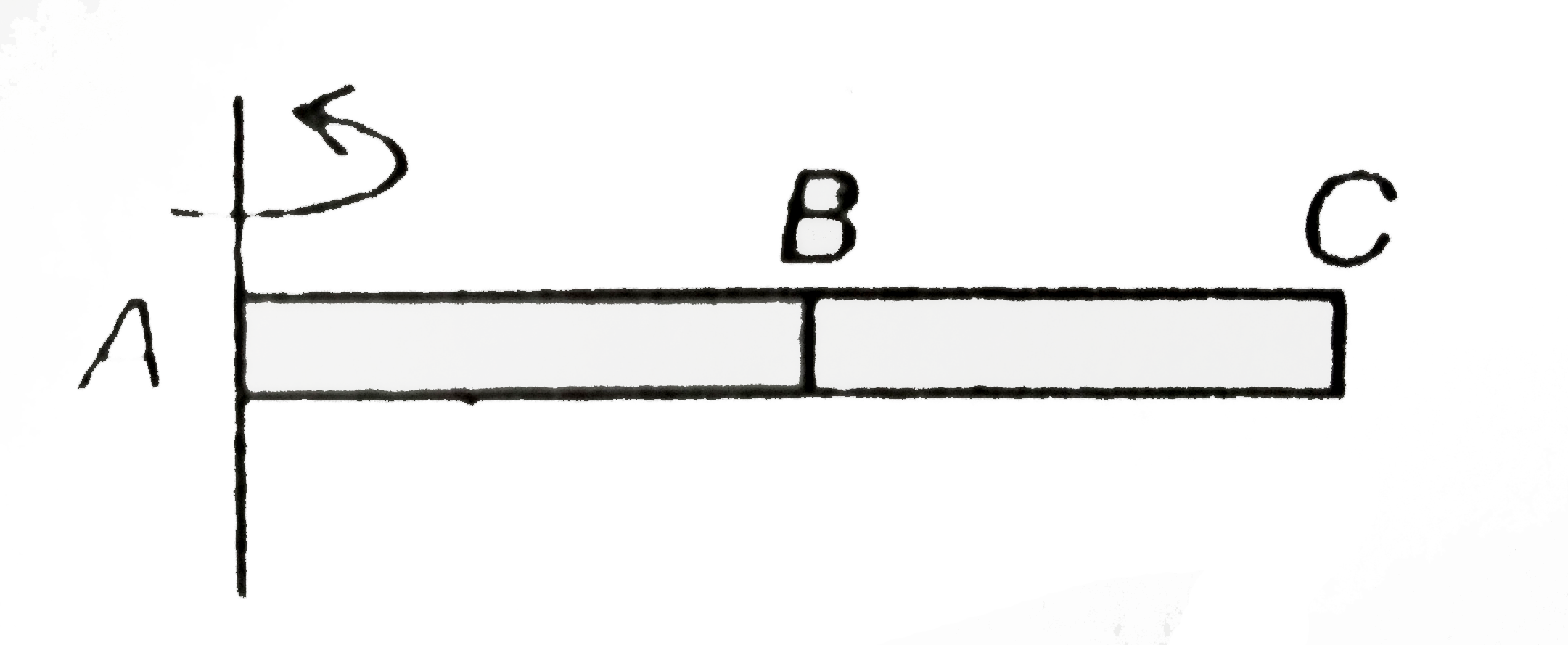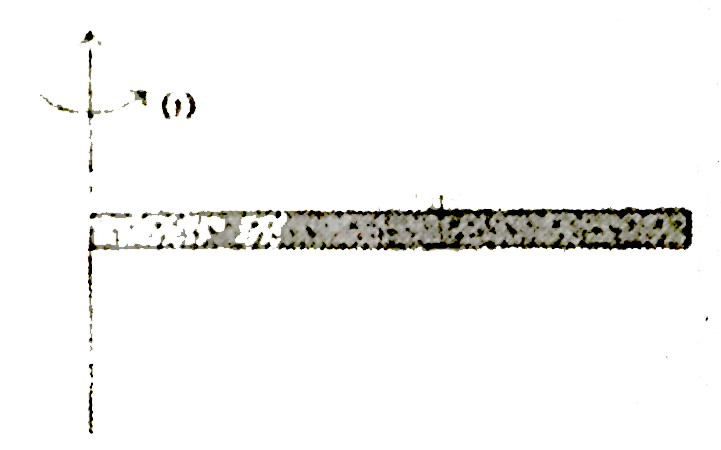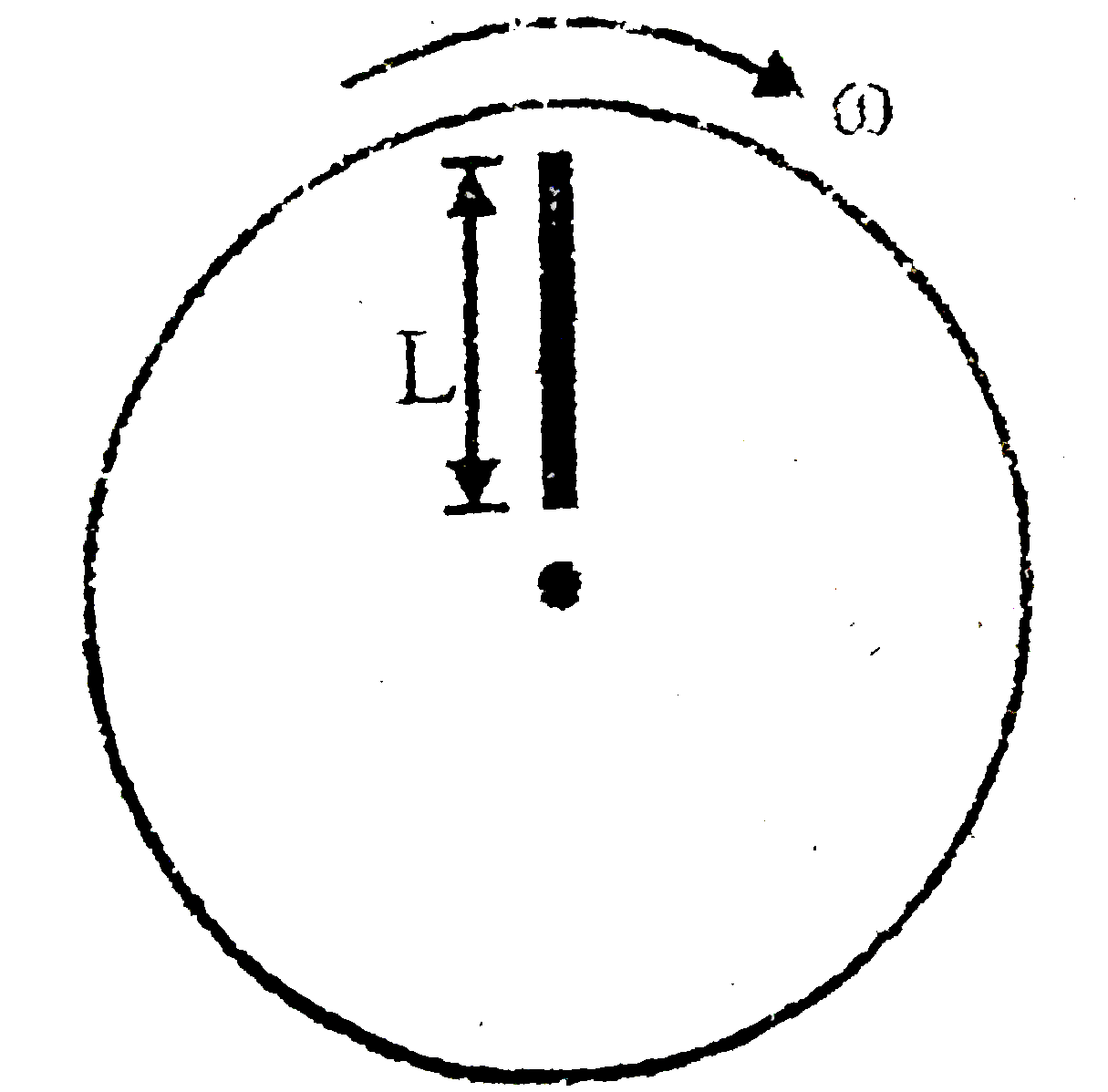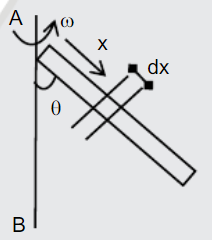A uniform rod of mass m and length l rotates in a horizontal plane with an angular velocity ω about a vertical axis passing through one end. The tension in the rod at a distance x from the axis is
12mω2x
12mω2(1−x2l)
12mω2l(1−x2l2)
12mω2l[1−xl]
To find the tension in a uniform rod of mass m and length l rotating about a vertical axis with an angular velocity ω, we can follow these steps:
Step 1: Understand the System
We have a uniform rod of length l and mass m rotating about a vertical axis at one end. The tension in the rod varies along its length due to the centripetal force required for circular motion.
Step 2: Define the Variables
Let:
- x = distance from the axis of rotation to the point where we want to find the tension.
- L−x = length of the remaining part of the rod from point x to the end of the rod.
- λ = mass per unit length of the rod, given by λ=ml.
Step 3: Calculate the Mass of the Segment
The mass of the segment of the rod from x to the end of the rod is:
m′=λ(L−x)=ml(l−x)=m(1−xl)
Step 4: Determine the Centripetal Force
The segment of the rod at distance x experiences a centripetal acceleration due to its rotation. The centripetal force required for this segment is provided by the tension T in the rod at distance x:
Fc=m′ω2x
Step 5: Set Up the Equation for Tension
The tension T at distance x must equal the centripetal force acting on the mass m′:
T=m′ω2x
Substituting m′:
T=(m(1−xl))ω2x
Step 6: Simplify the Expression
Now, simplifying the expression for tension:
T=mω2x(1−xl)
T=mω2x−mω2x2l
Final Expression for Tension
Thus, the tension in the rod at a distance x from the axis of rotation is given by:
T=mω2(x−x2l)
We have a uniform rod of length l and mass m rotating about a vertical axis at one end. The tension in the rod varies along its length due to the centripetal force required for circular motion.
Let:
- x = distance from the axis of rotation to the point where we want to find the tension.
- L−x = length of the remaining part of the rod from point x to the end of the rod.
- λ = mass per unit length of the rod, given by λ=ml.
The mass of the segment of the rod from x to the end of the rod is:
m′=λ(L−x)=ml(l−x)=m(1−xl)
The segment of the rod at distance x experiences a centripetal acceleration due to its rotation. The centripetal force required for this segment is provided by the tension T in the rod at distance x:
Fc=m′ω2x
The tension T at distance x must equal the centripetal force acting on the mass m′:
T=m′ω2x
Substituting m′:
T=(m(1−xl))ω2x
Now, simplifying the expression for tension:
T=mω2x(1−xl)
T=mω2x−mω2x2l
Thus, the tension in the rod at a distance x from the axis of rotation is given by:
T=mω2(x−x2l)
Topper's Solved these Questions
- ROTATIONAL MECHANICSBook:DC PANDEY ENGLISHChapter:ROTATIONAL MECHANICSExercise:Level 2 Multiple Correct
Explore 36 Videos
- ROTATIONAL MECHANICSBook:DC PANDEY ENGLISHChapter:ROTATIONAL MECHANICSExercise:Level 2
Explore 1 Video
- ROTATIONAL MECHANICSBook:DC PANDEY ENGLISHChapter:ROTATIONAL MECHANICSExercise:Level 1 Subjective
Explore 32 Videos
- ROTATIONBook:DC PANDEY ENGLISHChapter:ROTATIONExercise:(C) Chapter Exercises
Explore 39 Videos
- ROTATIONAL MOTIONBook:DC PANDEY ENGLISHChapter:ROTATIONAL MOTIONExercise:Integer Type Questions
Explore 17 Videos
Similar Questions
A uniform rod of length l is being rotated in a horizontal plane with a constant angular speed about an axis passing through one of its ends. If the tension generated in the rod due to rotation is T(x) at a distance x from the axis. Then which of the following graphs depicts it most closely?
View SolutionA uniform rod of mass m and length l0 is rotating with a constant angular speed ω about a vertical axis passing through its point of suspension. Find the moment of inertia of the rod about the axis of rotation if it make an angle θ to the vertical (axis of rotation).
View SolutionA thin uniform copper rod of length l and mass m rotates uniformly with an angular velocity ω in a horizontal plane about a vertical axis passing through one of its ends. Determine the tension in the rod as a function of the distance r from the rotation axis. Find the elongation of the rod.
View SolutionA uniform rod mass m and length l is provided at one end and is rotated with constant angular velocity ω in a horizontal plane. Tension in the rod at a distance (√3l/2) from pivoted end is (Assume gravity free space)
View SolutionA rod AB of length l is pivoted at an end A and freely rotated in a horizontal plane at an angular speed ω about a vertical axis passing through A. If coefficient of linear expansion of material of rod is α, find the percentage change in its angular velocity if temperature of system is incresed by ΔT
View SolutionA rigid rod of mass m and lengths l, is being rotated in horizontal plane about a vertical axis, passing through one end A. If TA,TBandTC are the tensions in rod at point A, mid point B and point C of rod repsectively, then

View SolutionA thin uniform copper rod length l and mass m rotates unifomly with an angular velocity ω about a vertical axis passing through one of its ends as shown in the figure. Young's modulus of copper is Y. Breaking stress is σmax, cross sectional area of rod is A and density of rod is uniform. Based on above information, answer the following questions
The maximum angular velocity with which the rod can rotate so that is won't break, is

View SolutionA uniform rod of mass m and length L lies radialy on a disc rotating with angular speed ω in a horizontal plane about vertical axis passing thorugh centre of disc. The rod does not slip on the disc and the centre of the rod is at a distance 2L from the centre of the disc. them the kinetic energy of the rod is

View SolutionA rod is rotating with angular velocity ω about axis AB. Find cosθ.

View SolutionA uniform rod of mass m and length L is free to rotate in the vertical plane about a horizontal axis passing through its end. The rod initially in horizontal position is released. The initial angular acceleration of the rod is:

View Solution